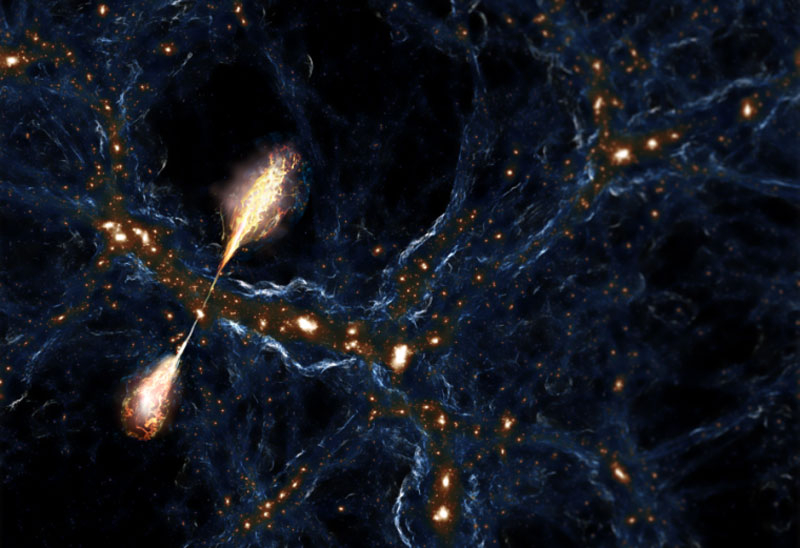It is known that streams of matter and energy escaping from black holes (jet) can quickly deprive the host galaxy of food for the birth of new stars and further growth. But now a discovery has been made that makes one suspect that jets influence universal processes. Scientists have discovered jets 23 million light years long – such jets will change the architecture of entire local areas of the Universe, and this is already a tool for the evolution of the universe.

Artist’s representation of jets from an active galaxy in a dark matter filament. Image Source: Caltech
Found by Caltech astronomers, the object of a pair of jets from an active galaxy extends approximately 7 Mpc (megaparsec). This is about the same as flying back and forth to our neighboring Andromeda galaxy five times. The ejection removed colossal energy from the supermassive black hole at the center of the host galaxy, comparable to the energy released during the collision of galaxy clusters (1055 J). In general, scientists were lucky with the discovery of this object. It was detected at the sensitivity limit of our instruments, and if it had arisen a little earlier or been a little weaker, the phenomenon would have gone unnoticed.
Due to its size, the object received the name of the giant Porphyrion from ancient Greek mythology. Its jets spread over 6.4 Mpc. Scientists estimate the true size of the jets to be just over 7 Mpc, since there are signs that we are observing them at a slight angle in our direction. The object itself was discovered in observational data from the LOFAR radio telescope over the Northern Hemisphere. They were put through a machine learning system and manual selection of freelance scientists. In total, over 11 thousand jets were discovered, which were more than one Mpc in length.
Data on Porphyrion were verified using another radio telescope, uGMRT, and supplemented with observations from the Keck Observatory. Measurements and spectral analysis showed that the probable galaxy – the source of the jets – is located at a distance of 6.3 billion years from the Big Bang. Jets of matter are usually ejected from the poles of a black hole, where they are guided and accelerated by its electromagnetic field. This is a natural particle accelerator, which in this case accelerated the jet matter (plasma) to a speed of 0.012 times the speed of light. To reach the observed sizes, the jets had to travel around the Universe for about 500 million years.

Image of jet trails in radio telescope data (bright areas indicate collisions of jets with matter)
Since the jets retained their shape and direction, scientists conclude that, firstly, the black hole that gave birth to them did not change its axis of rotation and, secondly, that the host galaxy is surrounded by voids (emptiness). The jets did not encounter enough matter—gas and dust—on their path to dissipate. This also means that the host galaxy was located in a thread of dark matter, which, like a web, permeates and connects the entire Universe and is the matrix for the formation of galaxies.
Taking into account the unprecedented extent of the discovered jets, they could become a carrier of mass and energy into neighboring filaments and, thus, could influence the basis for the formation of the fabric of the Universe itself. It is possible that we simply do not see all such phenomena, especially in the early stages of the formation of the universe, when the Universe was clearly denser. If there are many such objects and they appear quite often, they will probably have to be taken into account to model the evolution of galaxies and the Universe. But there is not enough data for this yet, so observations will continue.